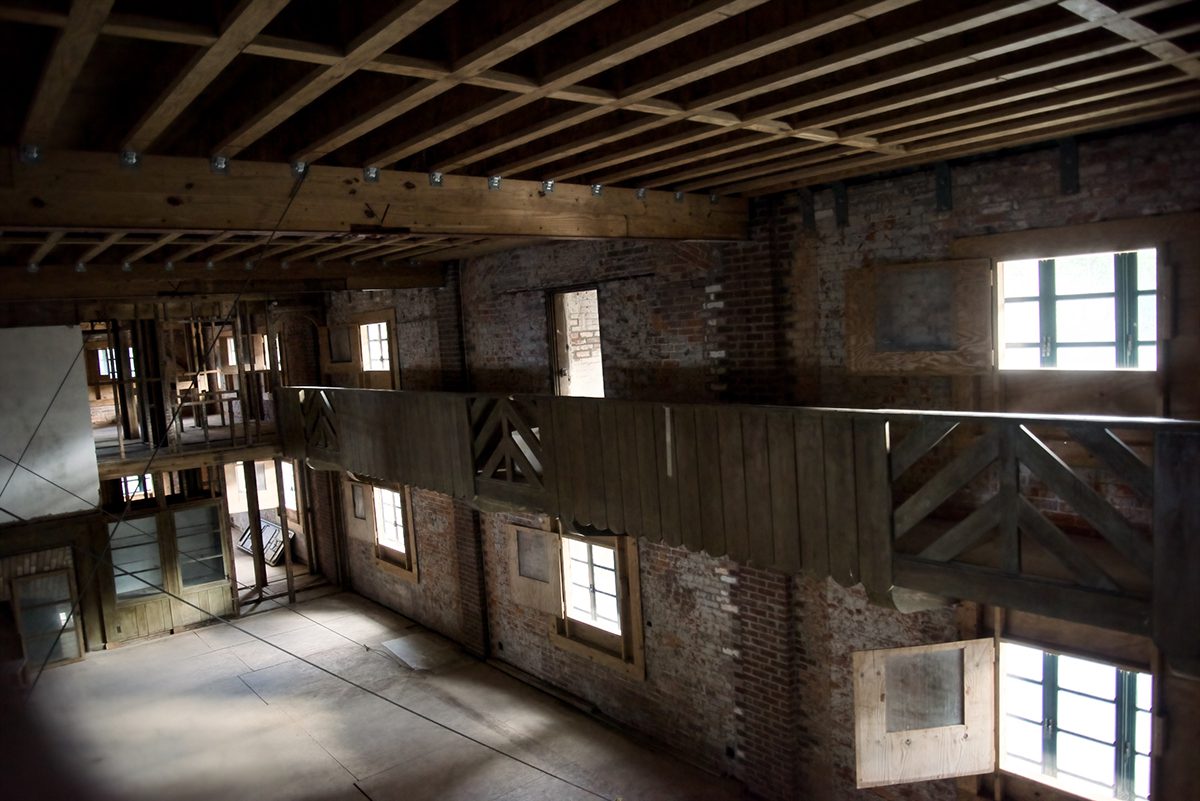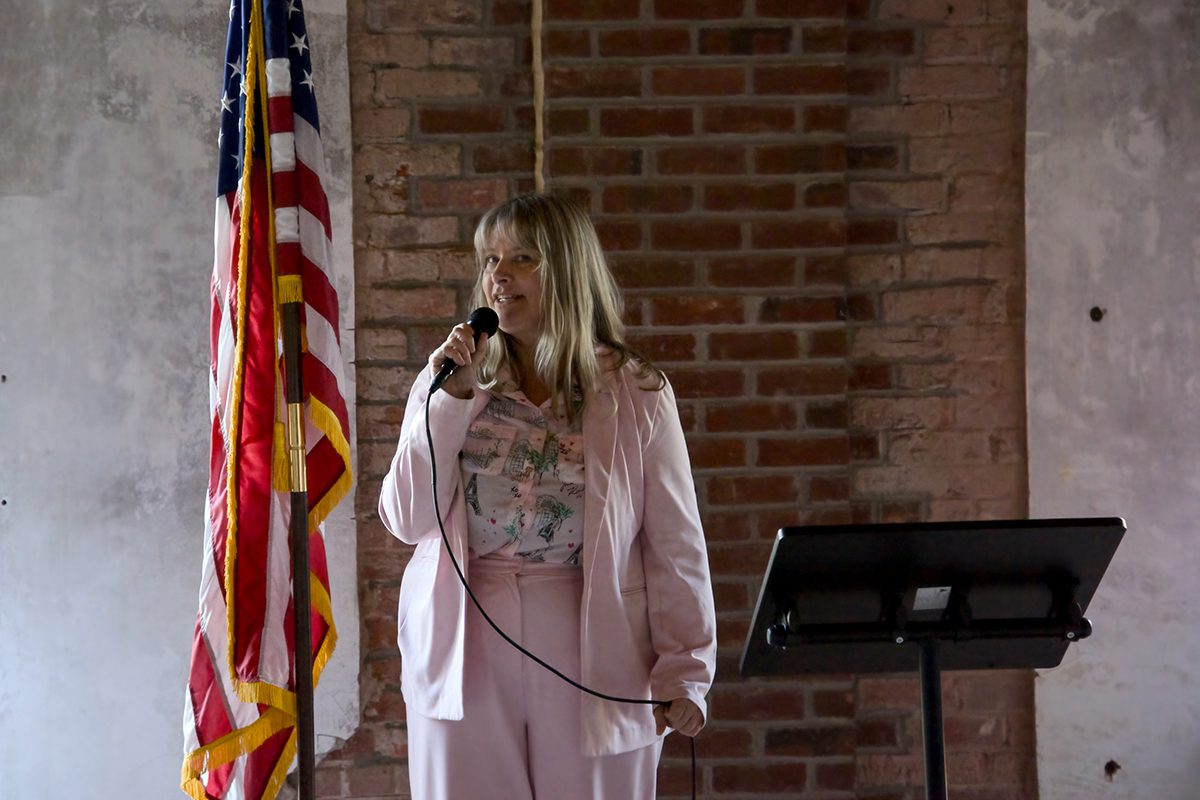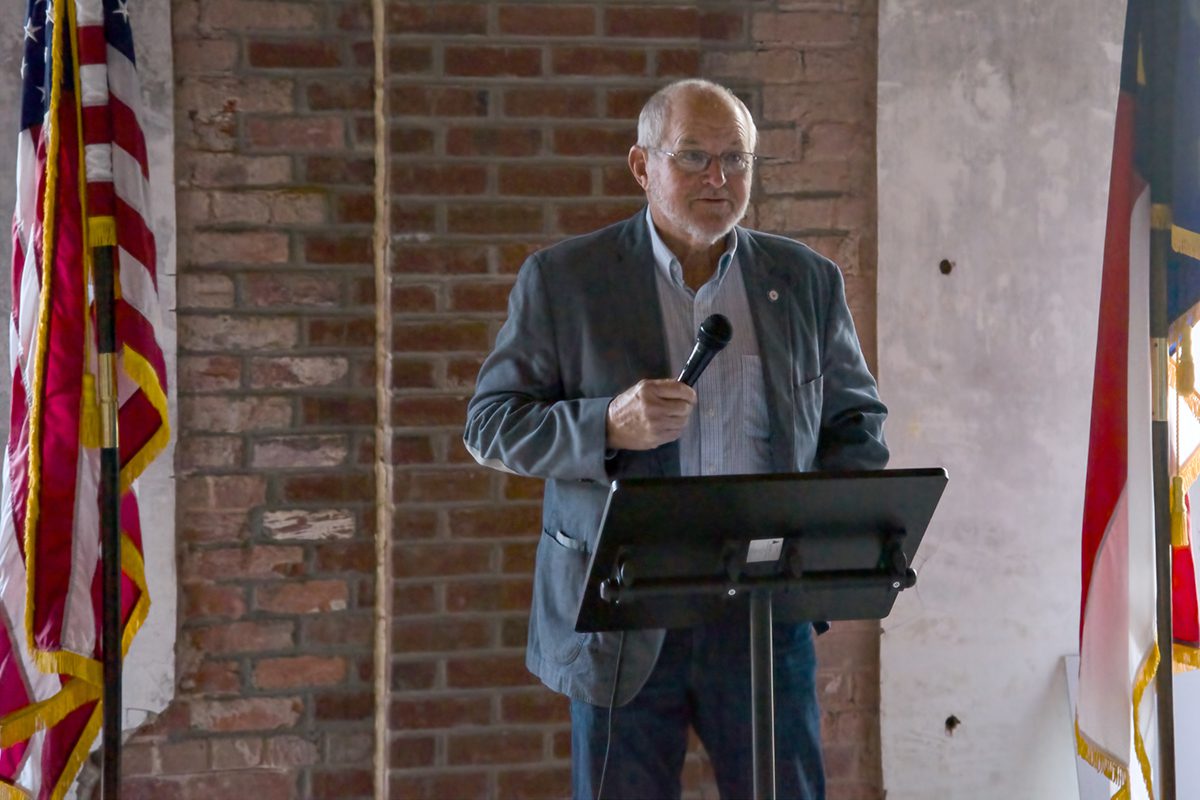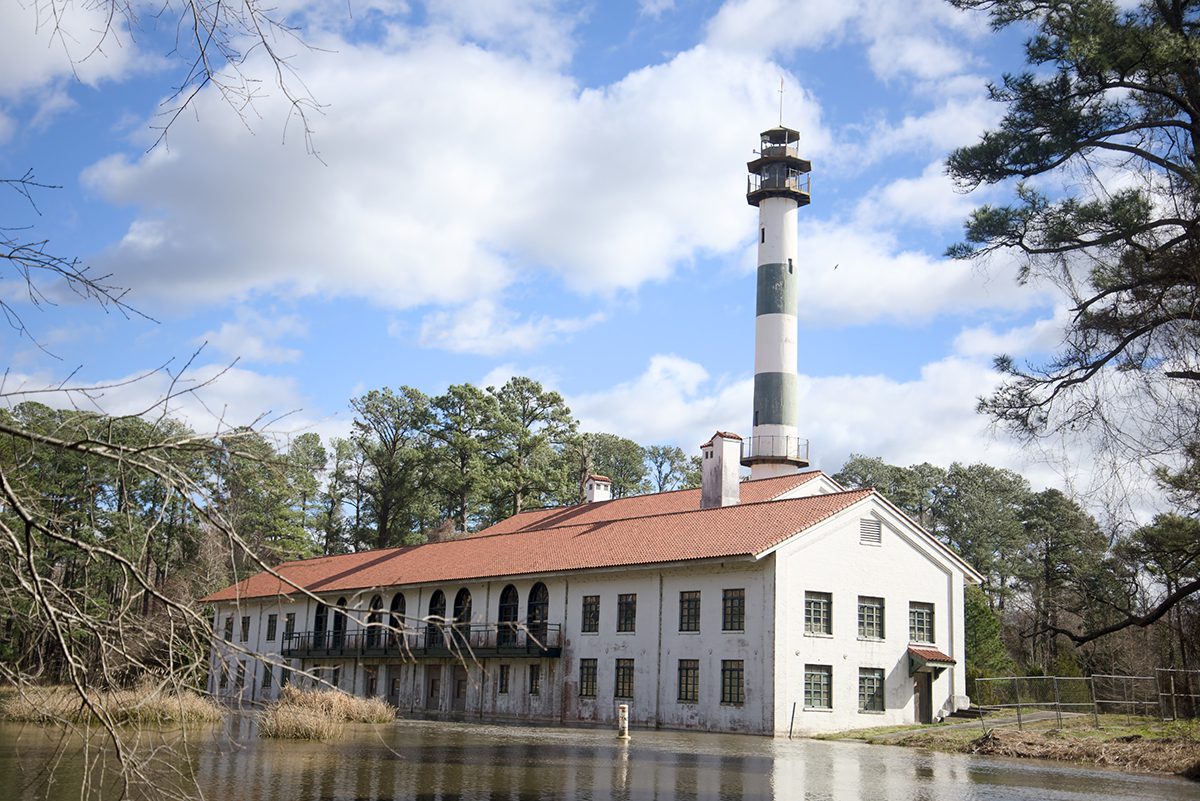
The future now looks brighter for a badly deteriorating structure that, despite its condition, remains an iconic symbol of mainland Hyde County’s heritage and a former gathering place for special events.
An event was held Feb. 13 and billed as the Mattamuskeet Lodge kickoff, a way to celebrate the $6.5 million in the 2024 North Carolina budget earmarked for the restoration of Lake Mattamuskeet Lodge.
Supporter Spotlight
The building was closed in 2000 when damage to its foundation was discovered during renovations. The foundation has subsequently been stabilized, and in 2020 the roof was repaired using many of the original clay terra cotta tiles.
After not being used for 24 years though, the interior is in need of restoration and there is landscaping and exterior work that also has to be addressed before the building can be used again.
The 2024 funding is an important first step and the path to get the money into the budget was difficult, Sen. Bobby Hanig, R-Currituck, told an audience of around 200 gathered at the celebration.
“It’s been a long, hard road with a lot of ups and downs and some obstacles we never thought we would overcome,” Hanig said.
The total cost for renovating the lodge, according to a report issued by the Mattamuskeet Lodge Society, will be $14.4 million. The society is a nonprofit established to manage the lodge after work is completed.
Supporter Spotlight
The speaker’s podium was shared by the North Carolina Wildlife Commission Executive Director Cameron Ingram, Sen. Norm Sanderson, R-Pamlico, and Rep. Keith Kidwell, R-Craven. Hyde County Manager County Manager Kris Noble and County Commission Chair Earl Pugh delivered personal remarks.

“We’ll be focused on this great land that surrounds us and the history that has been such a great part of all of our lives,” Noble said. “The lodge will once again be a center for events. We will once again host weddings. We will have proms and class reunions and other private events once again. As we breathe life back into the lodge, the lodge will also bring life back into our communities.”
Noble had earlier outlined for Coastal Review what she hoped the lodge will represent once renovations are completed and it reopens.
“One of the ultimate goals is to promote economic development. Mainland Hyde needs something like this, that will drive that economy,” she said.

Pugh, the county chair, described the lodge’s role in Hyde County during his remarks.
“Some of my memories here include proms, weddings, anniversaries, Ducks Unlimited banquets,” he said.
The lodge for many wildlife management students, including those from East Carolina University, was part of their college experience.
“I was in this building in 1992 as an ECU student in natural resource management,” Ingram said. “I didn’t know that I was going to eventually become a wildlife officer. But I knew that I wanted to serve public concern conservation in the state. So I was studying that here.”
Failed endeavor
Mattamuskeet Lodge was not originally a hunting lodge. It housed, when completed in 1915, what was purportedly the largest steam-powered pumping station in the world, capable of pumping a million gallons of water per minute. Its purpose was to drain Lake Mattamuskeet and turn the lakebed into fertile farmland. What is now an observation tower was originally the smokestack for the coal fires that fueled the steam.
In 1909, the North Carolina General Assembly passed the Drainage Act, “an act to promote the public health, convenience and welfare by leveeing, ditching and draining the wet, swamp and overflowed lands of the state.”
The measure created drainage districts throughout North Carolina, the most extensive of them was Lake Mattamuskeet. The rights to the lakebed were sold to the Southern Land Reclamation Co. for $100,000, with the proceeds going the state Board of Education.
The plan for the lake was based on a Dutch model, Farmer and Mechanic reported in November of 1914.
“In Holland the Haarlem Lake was drained by the government. This lake was not so large as Mattamuskeet and yet today 16,000 people live in this old lakebed and it is one of the most fertile and prosperous districts in Holland,” reporter R.R. Cotton wrote.
By 1918 the lake was pumped dry and the land was being sold to farmers.
The land was as fertile as advertised, but the cost of keeping the lakebed dry was becoming ever more expensive. By 1924 North Carolina Farms, the company formed to manage the land, was in receivership and all pumping activity stopped.
In 1926, with new investment, a second attempt was made to turn Lake Mattamuskeet into farmland. That too failed.
“Factory Farm Doomed by Nature, Millions Wasted,” the Associated Press reported in April 1931.
“Dixie’s greatest ‘factory farm’ apparently has failed,” according to the report. “Six years and $6,000,000 spent in an effort to reclaim for agriculture the 48,000 acre bed of Lake Mattamuskeet seems to have come to naught.”

As early as the mid-1920s, there were reports that the federal government was interested in Lake Mattamuskeet as a wildlife reserve, but the drainage district was still owned by private investors.
By the 1930s with the lake once again filled, word came that another plan to drain the lake was in the works. W.O. Saunders, publisher of the Elizabeth City Independent didn’t hold back in his assessment.
“Another Damphool Plan to Drain and Colonize Lake Mattamuskeet Acres,” the Independent’s front-page headline screamed.
In the article Saunders explained why draining the lake was a foolish plan.
“It is not practical as Lake Mattamuskeet is below sea level which would necessitate these pumps going continuously to prevent the farm crops from being inundated and destroyed,” he wrote.
According to the 1933 report, the pumps had failed in August 1932 and crops were lost.
Saunders goes on to note that Lake Mattmuskeet is a “Natural feeding ground for migratory water(fowl) and game fish, and proposes it be turned over to the Federal Government.”
He reported that the federal government wished to purchase the lake and turn it over to the U.S. Biological Survey, which was combined in 1940 with the Bureau of Fisheries to form the U.S. Fish and Wildlife Service.
By 1935, the Henderson Daily Dispatch was reporting that the old pumping station was being remodeled as a hotel and administration building.
The renovations took two years and, according to the website Living New Deal, the Civilian Conservation Corps was heavily involved in the work. CCC Co. 424 did much of the work, “with 17 to 23 year old ‘CCC boys’ working side by side with civilian contractors.”
Memories of migratory waterfowl
Sidney Britt, 88, was at the event. He owns a house on the lake now, but he lived in Raleigh when he first came to Lake Mattamuskeet as a boy.
“I was 10 years old. I was probably easy to impress,” he said. “You could stand in one spot and the horizon would just be dark with birds. It was just beautiful. And the sound. It was just beautiful.”
By the 1970s, though, hunting had dwindled as geese flight patterns had evidently changed. The Perquimans Weekly in a July 1973 article noted that, “Surprisingly, the total population of Canada geese in the Atlantic Flyway has increased at the same time that Mattamuskeet’s population has declined.”
In 1974 the Mattamuskeet Lodge was closed, but U.S. Fish and Wildlife Service offices were still in the building, which had become a gathering place for Hyde County events –high school proms, weddings and the like.
The Mattamuskeet U.S. Fish and Wildlife Service office is now located on an adjacent property.
The lodge also included a dormitory for ECU students with 16 beds available.
“I was the lodge coordinator,” Annette Gibbs told Coastal Review at the celebration. “I had an office here, and I booked all parties and the people that came and stayed in the ECU wing. We had something going on almost every week.”
It all came to an end in 2000.
The building had been deteriorating for some time, and money finally became available for needed repairs. A close look at the foundations, however, revealed that the bricks holding the building up were disintegrating.
“We had the money (for renovations) and we were pulling out bricks and they found some that were down low would actually break off,” Gibbs said. “The problem was they used sand from the sound (to make the bricks). And there was salt in the sand and it had just disintegrated.”
The structural problems were repaired, but it used all the money that had been earmarked for the renovation. In 2020 the roof was replaced.
Structurally, the building is sound, but there is considerable interior work that has to be done. Many of the touches the Lodge created are still there — the balcony surrounding what could be a ballroom, rooms are still divided, but walking through the building, there can be no doubt the interior is an empty shell.

Plans for the structure
It may take years to completely renovate the building.
Legislators at the event explained that money allocated in a budget must be spent during that fiscal year. They were optimistic that once the project began, funding to complete the renovation would continue to be available.
Once renovations are completed, the Hyde County Extension Service will move their offices to the building.
“Hyde County’s cooperative extension will have their offices here in the lodge and they will provide the abundant programming and resources that they already provide,” Noble said during her remarks.
Related: Hyde County agency’s future home may be key to saving it
The Mattamuskeet Lodge Society will manage the facility when it opens and its planning documents call for extensive outreach to area schools for educational opportunities.
“The Lodge will offer educational programming through the MLS (Mattamuskeet Lodge Society), 4-H Youth Development Program, Family & Consumer Sciences, Agriculture Extension, NCWRC, and FWS,” the society notes in its Restoration Initiative document.
The lodge will also be available once again for special events and the Lodge Society will also manage a retail store on premises.
“It will all be focused on this great land that surrounds us and the history that has been such a great part of all of our lives,” Noble said.







